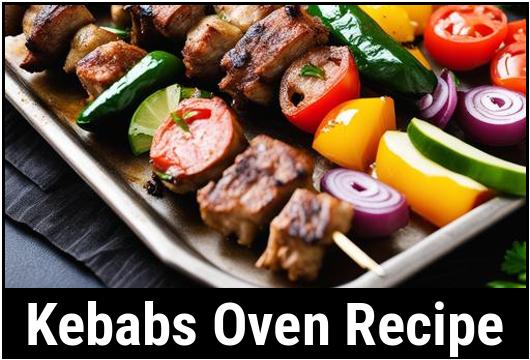
The Ultimate Guide To Perfectly Cooked Kebabs: Oven Recipe
Kebabs, a tantalizing Turkish delicacy, have gained immense popularity worldwide due to their exotic flavors and succulent textures. Traditionally cooked over open flames, kebabs are versatile and can be prepared with various meats, vegetables, and seasonings. In this comprehensive guide, we will explore the science behind cooking kebabs in the oven, delve into culinary details, provide tips for selection, cleaning, and preparation, discuss variations and doneness checks, and finally present a delectable kebab oven recipe. Get ready to embark on a culinary journey that will leave your taste buds craving for more!
Understanding the Food Science Behind Kebabs
Before we dive into the details of cooking kebabs in the oven, it is essential to understand the food science behind this mouthwatering delight. Kebabs primarily consist of meat, vegetables, and spices, which, when combined and cooked, undergo a series of fascinating chemical reactions.
Meat plays a crucial role in kebabs, as it provides the protein and fat necessary for a tender and flavorsome end-result. Depending on your preference, you can choose from a wide variety of meats, such as chicken, beef, lamb, or even seafood like shrimp or fish. The choice of meat strongly influences the overall taste and texture of your kebabs.
Vegetables add vibrancy, flavor, and essential nutrients to kebabs. Popular choices include bell peppers, onions, cherry tomatoes, zucchini, and mushrooms. The moisture from the vegetables also helps keep the kebabs tender during the cooking process.
Spices and seasonings, which vary depending on regional and personal preferences, bring the kebabs to life. Common spices used in kebabs include cumin, paprika, garlic, onion powder, and turmeric. These aromatic spices infuse the meat and vegetables with an irresistible aroma and depth of flavor.
Culinary Details: Selection, Cleaning, and Preparation
Meat Selection
When preparing kebabs, choosing the right quality and cut of meat is paramount to achieving tender and succulent results. Opt for fresh, lean cuts of meat that are not excessively marbled with fat. Tender cuts like chicken breast, rib-eye steak, or lamb leg work exceptionally well for kebabs. The meat should be free from any odors or discoloration, indicating its freshness and quality.
Vegetable Selection
Similarly, selecting fresh, high-quality vegetables is crucial to enhance the overall flavor and texture of your kebabs. Choose vegetables that are firm, brightly colored, and in their prime. This ensures that they contribute the desired juiciness and texture to your kebabs. Aim for a variety of colors and textures to create an eye-catching and flavorful skewer.
Cleaning and Preparation
Once you have selected your ingredients, it’s time to clean and prepare them for skewering. It is essential to wash all fruits, vegetables, and herbs thoroughly to remove any dirt or residue. Pat them dry with a clean kitchen towel to prevent excess moisture during the cooking process.
For meat, carefully trim off any excess fat or silver skin to promote even cooking. Cut the meat into uniformly-sized cubes or strips to ensure consistent doneness and allow for even distribution of flavors.
Marinades and Seasoning
Marinating your kebabs is an excellent technique to infuse them with additional flavors and tenderize the meat further. Prepare a marinade by combining your choice of oil, acid (such as lemon juice or vinegar), spices, herbs, and any additional seasonings like soy sauce or Worcestershire sauce.
Allow the meat and vegetables to marinate for at least 30 minutes, or preferably overnight in the refrigerator. The longer the marination time, the more intense the flavors become. Remember to reserve some marinade for basting during the cooking process.
Tips for Perfectly Cooked Kebabs
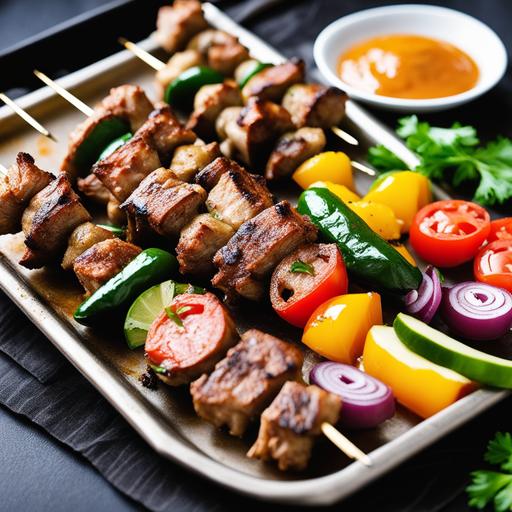
Now that we have covered the culinary details from selecting ingredients to preparation, let’s explore some expert tips to ensure your kebabs turn out perfectly cooked every time.
-
Preheating the Oven: Always preheat your oven to the recommended temperature mentioned in the recipe. This ensures even cooking throughout and prevents the kebabs from becoming dry.
-
Skewer Arrangement: When threading the skewers, alternate between meat and vegetables to ensure even cooking. This also creates an attractive visual appeal.
-
Spacing on the Baking Sheet: Leave enough space between each skewer on the baking sheet to allow for proper air circulation. This ensures even browning and prevents the kebabs from steaming.
-
Basting: Regularly basting the kebabs with reserved marinade or a flavorful sauce during cooking helps retain moisture and intensifies the flavors. Baste approximately every 5-7 minutes for optimal results.
-
Checking for Doneness: To determine if your kebabs are cooked, insert an instant-read meat thermometer into the thickest part of the meat. Chicken should register at least 165°F (74°C), beef and lamb at 145°F (63°C) for medium-rare, and vegetables should be tender but not overly soft.
-
Resting Period: Allow the kebabs to rest for a few minutes after cooking. This allows the juices to redistribute, resulting in more flavorful and succulent kebabs.
Variations of Kebabs
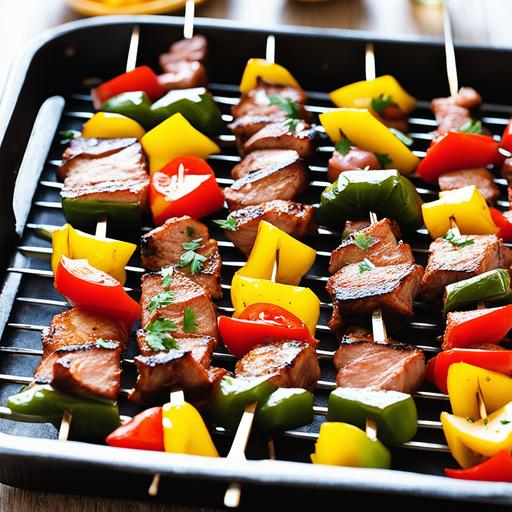
Kebabs provide endless opportunities for creativity and culinary exploration. Here are a few popular variations to tempt your taste buds:
-
Shish Kebabs: Classic kebabs on skewers, traditionally made with lamb, marinated in flavorsome spices, and grilled to perfection.
-
Tikka Kebabs: A popular Indian variation, often made with chicken or paneer (Indian cheese) marinated in a spiced yogurt mixture and baked or grilled.
-
Kofta Kebabs: Ground meat (such as lamb, beef, or chicken) mixed with aromatic spices, herbs, and onions, shaped into meatballs, and then skewered and cooked.
-
Veggie Kebabs: Perfect for vegetarians or those seeking a plant-based option. Combine a colorful assortment of marinated vegetables, tofu, or seitan on skewers for a delightful vegetarian kebab experience.
Recipe: Oven-Baked Kebabs for your Culinary Delight
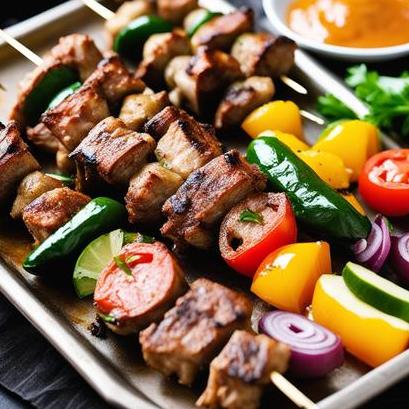
Now that you are well-versed in the art of kebab preparation, it’s time to delve into an irresistible kebab oven recipe that will leave you and your guests craving for more!
Ingredients:
-
1 pound boneless chicken breast, cut into 1-inch cubes
-
1 red bell pepper, cut into chunks
-
1 yellow bell pepper, cut into chunks
-
1 red onion, cut into chunks
-
1 cup cherry tomatoes
-
2 tablespoons olive oil
-
2 tablespoons lemon juice
-
2 garlic cloves, minced
-
1 teaspoon ground cumin
-
1 teaspoon paprika
-
1 teaspoon dried oregano
-
Salt and pepper to taste
-
Wooden or metal skewers
Instructions:
-
In a large bowl, combine olive oil, lemon juice, minced garlic, ground cumin, paprika, dried oregano, salt, and pepper. Mix well to create the marinade.
-
Add the chicken cubes to the marinade and toss to coat. Cover the bowl and let the chicken marinate in the refrigerator for at least 30 minutes, or ideally overnight.
-
Preheat your oven to 425°F (220°C) and line a baking sheet with parchment paper.
-
Meanwhile, soak wooden skewers in water for approximately 30 minutes to prevent them from burning during cooking.
-
Thread the marinated chicken, bell peppers, onion, and cherry tomatoes onto the skewers, alternating between ingredients.
-
Arrange the skewers on the prepared baking sheet, leaving some space between each skewer.
-
Place the baking sheet with the skewers in the preheated oven and cook for approximately 20-25 minutes, or until the chicken is cooked through and the vegetables are tender.
-
Every 5-7 minutes, baste the kebabs with additional marinade or your preferred sauce to keep them moist and flavorful.
-
Once cooked, remove the kebabs from the oven and allow them to rest for a few minutes.
-
Serve the kebabs hot, garnished with fresh herbs and accompanied by pita bread, a side salad, or your favorite dipping sauce.
Whether you’re hosting a casual gathering or treating yourself to a delightful meal, these oven-baked kebabs are bound to impress. Experiment with different combinations of meats, vegetables, and spices to create your signature kebab recipe.
Avoiding Common Mistakes: Overcooking and Undercooking
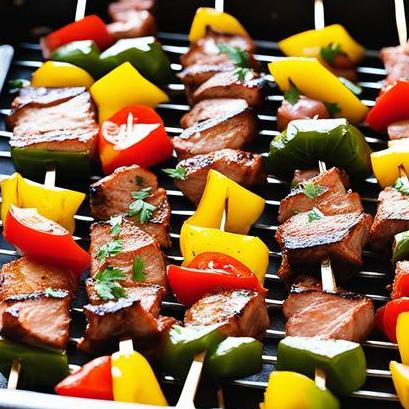
To ensure your kebabs turn out perfectly cooked, it’s essential to avoid two common mistakes – overcooking and undercooking.
Overcooking: Overcooking kebabs can lead to dry, tough, and unappetizing results. To prevent this, make sure to monitor the cooking time and temperature closely. Basting the kebabs regularly also helps retain moisture.
Undercooking: Undercooked kebabs can pose health risks, especially when it comes to poultry. Always check for doneness using an instant-read meat thermometer, ensuring the meat reaches the recommended temperature to eliminate any pathogens.
In Conclusion
Cooking kebabs in the oven opens up a world of possibilities to savor this beloved dish year-round, regardless of the availability of outdoor grilling space. By selecting high-quality ingredients, mastering culinary techniques, and experimenting with flavors, you can create succulent and flavorsome kebabs that will leave a lasting impression on your palate.
Remember to unleash your creativity, put your culinary skills to the test, and enjoy the unique experience of preparing and indulging in homemade fiery kebabs infused with mouthwatering flavors from around the world. Bon appétit!
Sources
FAQS On Kebabs Oven Recipe
What Type Of Meat Is Best For Making Kebabs In The Oven?
For making kebabs in the oven, lean cuts of meat such as chicken breast, beef tenderloin, or lamb leg are ideal. These cuts will cook evenly and retain their tenderness when cooked in the oven.
How Should I Marinate The Meat For Kebabs Before Cooking In The Oven?
To add flavor to the kebabs, marinate the meat with a mixture of yogurt, lemon juice, olive oil, and various spices such as cumin, paprika, and garlic. Let the meat marinate for at least 2 hours, or ideally overnight, for maximum flavor.
What Type Of Vegetables Can Be Added To Kebabs Cooked In The Oven?
Vegetables such as bell peppers, onions, zucchini, and cherry tomatoes are great additions to kebabs cooked in the oven. Cut the vegetables into bite-sized pieces and thread them onto the skewers along with the marinated meat.
How Long Should I Cook The Kebabs In The Oven?
Preheat the oven to 425°F (220°C) and place the kebabs on a lined baking sheet. Cook the kebabs for 15-20 minutes, flipping them halfway through, or until the meat is fully cooked and the vegetables are tender.
What Are Some Recommended Sides To Serve With Kebabs Cooked In The Oven?
Serve the kebabs with a side of fluffy couscous, a fresh Greek salad, or some warm pita bread. Another great option is to serve the kebabs with a creamy tzatziki sauce for dipping.



